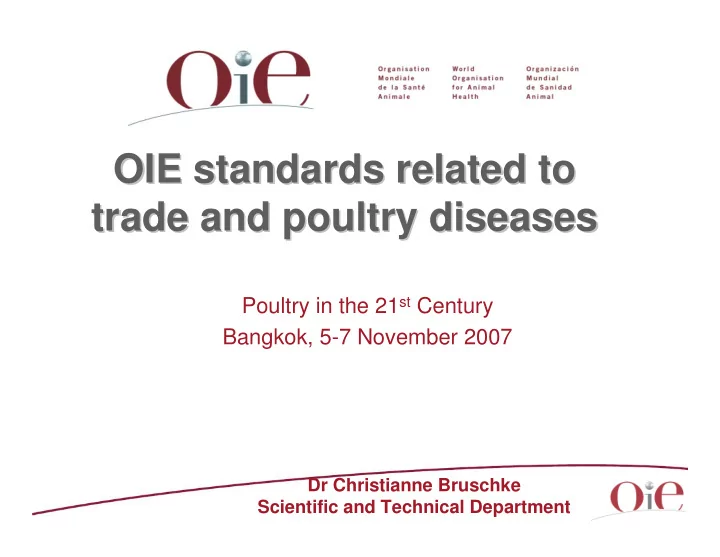

OIE standards related related to to OIE standards trade and and poultry poultry diseases diseases trade Poultry in the 21 st Century Bangkok, 5-7 November 2007 Dr Christianne Bruschke Scientific and Technical Department
OIE Standards for Terrestrial OIE Standards for Terrestrial Animals Animals Terrestrial Animal Health Code (the Terrestrial Code) • Manual of Diagnostic Tests and Vaccines for Terrestrial Animals (the Terrestrial Manual)
OIE listed avian diseases OIE listed avian diseases Avian Chlamydiosis (Ch 2.7.4) Avian Infectious bronchitis (Ch 2.7.6) Avian infectious laryngotracheitis (Ch 2.7.7) Avian Mycoplasmosis (Ch 2.7.3) Duck Virus Hepatitis (Ch 2.7.9) Fowl Cholera (Ch 2.7.11) Fowl Typhoid (Ch 2.7.5) HPAI (Ch 2.7.12) Newcastle Disease (Ch 2.7.13) Infectious Bursal Disease (Ch 2.7.1) Marek’s Disease (Ch 2.7.2) Pullorum Disease (Ch 2.7.5) Turkey Rhinotracheitis (under development)
Zoning and Compartmentalisation Zoning and Compartmentalisation Establishing and maintaining of a disease-free status may be difficult for an entire country To establish and maintain a subpopulation with a different health status within the national borders Allows a concentration of resources where there is greatest chance of success in controlling or eradicating a disease gaining or maintaining market access for certain commodities
Relevant OIE information Relevant OIE information Code Chapter 1.3.5 . Zoning and Compartmentalisation Appendix 3.Y.Y . General Guidelines on the Application of Compartmentalisation (under development) Checklist on Practical Application of Compartmentalisation in the Poultry Industry Appendix 3.8.1. General Guidelines on Animal Health Surveillance Chapters 1.3.3. and 1.3.4 . Evaluation of Veterinary Services Appendix 3.5.1 . General Principles for the Identification and Traceability of Live Animals
OIE definitions (chapter 1.1.1) OIE definitions (chapter 1.1.1) Zone/Region: : a clearly a clearly defined defined part of a country part of a country …… …… Zone/Region Compartment : : One or more establishments One or more establishments (premises in (premises in Compartment which animals are kept) under a clearly defined common common which animals are kept) under a clearly defined biosecurity management system …… …….. .. biosecurity management system …. .… … containing an animal containing an animal sub sub- -population population with a with a distinct distinct … health status with respect to a specific disease or diseases with respect to a specific disease or diseases health status or which required surveillance, control and biosecurity or which required surveillance, control and biosecurity measures have been applied for the purpose of international measures have been applied for the purpose of international trade trade
zones zones B major FREE ZONE U F F E road R Z O N E INFECTED ZONE R E F railway F U B E N river O Z FREE ZONE
Compartment Compartment BREEDING FEED FLOCK SUPPLY GROWING FLOCK SLAUGHTER GROWING HOUSE FLOCK
Some principles in defining a zone Some principles in defining a zone or compartment or compartment Veterinary Services should clearly define the Veterinary Services should clearly define the subpopulation in accordance with code chapters on subpopulation in accordance with code chapters on surveillance and traceability surveillance and traceability Procedures to maintain the distinct health status depend Procedures to maintain the distinct health status depend on epidemiology, environment and applicable biosecurity on epidemiology, environment and applicable biosecurity measures measures Biosecurity and surveillance / monitoring are always Biosecurity and surveillance / monitoring are always essential components essential components Both Industry and Veterinary Services have Both Industry and Veterinary Services have responsibilities responsibilities
Compartmentalisation:Industry Compartmentalisation:Industry Responsibilities esponsibilities R Biosecurity plan and application of biosecurity measures Implementation of QA schemes Monitoring efficacy of all (biosecurity) measures Documentation of corrective actions Conducting Surveillance Reporting of any suspicion or infection
Compartmentalisation: Compartmentalisation: Veterinary Services Services Veterinary Responsibilities Responsibilities Periodic inspections Facilities Biosecurity Plan Records Surveillance procedures and results Movement certification
Application Application Not all situations led themselves to the application of zoning/compartmentalisation effective implementation of the concept will be influenced by technical issues: epidemiology of the disease(s) of concern structure and distribution of the poultry population country and infrastructure factors environmental factors the biosecurity measures which may be applicable the health status of animals in adjacent areas necessary surveillance , in and out of the zone or compartment
Uses of compartmentalisation Uses of compartmentalisation in disease control / eradication campaign in disease control / eradication campaign progressive zoning/compartmentalisation allows stepwise progressive zoning/compartmentalisation allows stepwise approach approach Zoning and compartmentalisation may go hand in hand Zoning and compartmentalisation may go hand in hand allows concentration of resources where greatest chance allows concentration of resources where greatest chance of success of success in trade zone in trade zone to gain / maintain market access for certain commodities to gain / maintain market access for certain commodities where whole country freedom is not possible or where whole country freedom is not possible or practicable practicable
Organisation Mondiale de la Santé Animale World Organisation for Animal Health Organización Mundial de Sanidad Animal 12 rue de Prony, 75017 Paris, France - www.oie.int – oie@oie.int
Recommend
More recommend